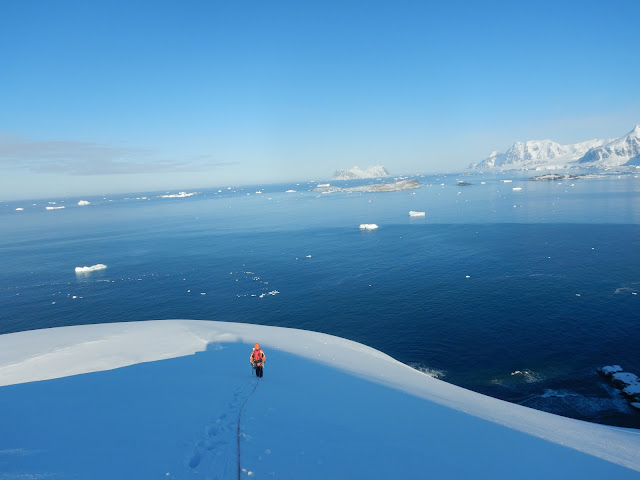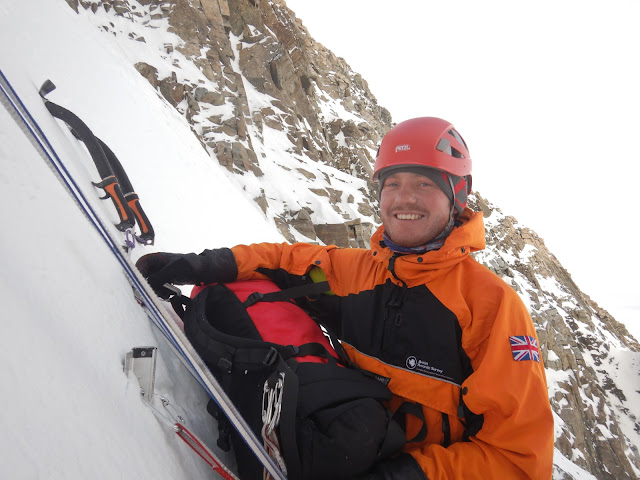Out With The Field Guides
The British Antarctic Survey (BAS) employs several field guides to support operations in the deep field which occur across the busy austral summer. During the period of maximal daylight, from November to February, the station buzzes with scientific projects optimising the long daylight hours. Projects range from geological expeditions and drilling ice cores to maintaining weather stations and installing antennas (find out more here about ice chemistry and geological research). The transition from a busy summer season to the quiet winter is marked by the departure of the final plane and cargo vessel - this concludes the summer season. Only twenty-three personnel remain on station, isolated for eight months of winter.
Four field guides remain as part of our core wintering team. The wintering team conducts various training modules with the field guides in order to prepare for Antarctic conditions. The British Antarctic Survey consider this as essential training and it offers us the chance to take a break from our working routine. We are very fortunate in that each person has the opportunity to go out with a field guide for two winter trips where we can explore places further from base and climb new peaks, establish new climbing routes and live in a red pyramid tent for a week. The trips are highly weather dependant and organised ahead of time so if your week falls onto a bad weather window, you may have to accept that you will spend a week on station (which has consisted of tents being installed in the lounge in past winters!) Whilst these trips are certainly a fantastic and unique experience for us, we can also practice new skills (eg. mixed climbing, building ice anchors, using ice tools, building rescue systems etc.), familiarise ourselves with field equipment and become acquainted with "living in the field".
It's great to be working at a research station where field guides take us out for educational recreation as part of our jobs. BAS and Rothera station recognise the value of outside activities and adventure in maintaining physical and mental wellbeing. It is clear to see the delight that fellow colleagues have shared when recounting stories from their winter trip.
Walking across Reptile Ridge roped up with Mark, one of the field guides.
In preparation for our winter trip, the field guides have taken us out climbing in the local surroundings. I began my first mixed climbing (a combination of ice and rock climbing) route at Expedition Buttress, a snow filled gully just west of the station overlooking the local ski area ('the ramp'). Suited with a harness, a climbing rack, crevasse rescue kit and armed with ice axes, I stood at the base of a wind scoop (a depression in the snow near an object, ie. a mountain, caused by deflected wind action) and belayed Mark as he was leading the route and fixing anchor points (in the form of cams - a spring loaded camming device that is wedged into rock cracks - and nuts - metal devices placed in constrictions in cracks, attached to a carabiner with a sling and clipped directly onto our climbing rope). Using a series of commands; 'I am safe', 'that's me', 'off belay', 'start climbing' I began moving up the gully, finding footholds in the rock and placing ice axes into the snow as hand leavers.
Mark walking towards the wind scoop, ice axe at the ready
Exhibition Buttress - view from the belayer (the person who controls the release of the ropes for security)
The summit- essential snacking
View of Ryder Bay from Reptile Ridge
Ed, another field guide, introduced Niall (Plant Operator) and myself to the Antarctic gear as we ventured beyond the 'flagline'. The flagline is area demarcated by flags, regularly surveyed with a Ground Penetrating Radar (GPR) for subsurface crevasses. Whilst always remaining vigilant, when engaging in recreational activities within this area, we do not need to carry specialist equipment. However, once we leave the flags, it's crucial that we are roped up and armed with crevasse rescue tools: snow stakes (to build an anchor), jumars, pulleys and slings. To provide good grip on the ice and steep rock, we fit crampons to our mountaineering boots. I distinctly remember experiencing a strange sensation when taking those first steps with large triangular spikes on my feet! We are always roped together (donning a series of alpine coils across our shoulder and tying a figure of eight into our harness) and we move with a distance between us (keeping the rope in tension) as we make fresh footsteps across the ridges and flat white expanses.
Niall roped in, wearing alpine coils and sporting crampons.
The four seasons of Antarctica- initially we commenced the climb in almost 'white-out' conditions
Once we began to master the basics of climbing in snow regions, Andy (field guide) treated Niall and I to a Sunday daytrip outside of the local travel area in early April. With the wind chill factor, we experienced temperatures of -15°C! We travelled on skidoos to a peak called N26 and caught the rising sun. The three of us travelled in a line, wearing a full crevasse-rescue harness and linked up with a rope between each skidoo. The linkage line must be closely surveyed, too tight and the leading skidoo will become damaged by effectively pulling the following skidoo, too slack and the line is subject to getting caught in the skidoo skis. As we were travelling on ground that is not regularly surveyed by the GPR, the risks of falling into crevasses is heightened and we must take caution. In the eventually that the leading skidoo was to fall into a crevasse, the rope between the skidoos will act as an anchor and the following team would perform a crevasse rescue and run-out a pully/jumar system to retrieve the casualty.
Skidoo travel as the sun was rising across the Western Antarctic Peninsula mountains.
Niall and I commence the N26 climb, skidoos parked in the foreground
Andy having a chocolate break before removing the snow-stake anchor.
Rewarming with down jackets, hot juice & a quick lunch on the last section of N26, before it got too cold!
The fourth field guide, Jean-Baptiste, took me to a local crevasse which is 20 m deep and only a 30 minute walk away from station. Our aim was to explore the techniques of ice climbing on a vertical wall. It was a windy afternoon and the snow was whipping our face and numbing our cheeks. We uncovered the snowed-in door that the carpenter had installed across the crevasse and slowly abseiled down from our anchor point. The moment we ducked below the soft snow, the wind ceased and an overwhelming silence filled the air. The ice below me was so blue and beautiful. Despite only being a 20 m wall, the technique of ice climbing is unique and requires practise. I quickly felt a strong burn in my forearms and calves and had to regularly pause. The trick is using force to kick your crampons into the wall and implant the ice axe firmly into the wall. Jean-Baptise and I had both forgotten our cameras (typical), so I am attaching a photo of Ryan's (Marine Assistant) exploration in the same crevasse ...
Ryan exploring the local crevasse- Photo credit: Jaskiran Nagi
I am due to go on my winter trip on 10th May with the boating officer, Pete. We will each be accompanied by a field guide (Ed and Mark) and therefore the four of us will camp together. The heart of winter (21st June) is fast approaching and the cold is gripping - removing your gloves even for a minute is detrimental. Last weekend, Ed took Pete and I mountaineering on Reptile Ridge in conditions that we are likely to experience on our trip, -20°C air and cold winds. As I write, I can envisage our station leader (Matthew Phillips) saying 'eat some cement' (ie. get tougher!). Effectively, we will be 'glamping' with abundant warm food and a tilly lamp to heat the tent and dry out our clothes.
This, of course, is nothing compared to what Shackleton and him men suffered during the 1914-1917 transantarctic expedition when 'Endurance' became trapped in pack ice in the Weddell sea. I am currently reading an extremely gripping recount of 'Endurance: Shackleton's incredible voyage' by Alfred Lansing. I highly recommend it to anyone interested in Antarctic exploration and survival! I hope to finish it in the tent and although I'll be reading it in Antarctica, I feel a million miles away from what those arduous explorers endured for so long. I cannot help discuss this perspective with Ryan as we go out on the water for a few hours of weekly water sampling - on windy days, we are eager to get back to a hot lunch as our faces are freezing, and our feet and hands numb!
Ed, Pete and I moving across Reptile Ridge with minimal stops to keep warm!
Learning how to belay the 'old school way' without a device - using just a rope around your waist
Our back garden - Reptile Ridge

























Wow! Just Wow!
ReplyDeleteAnd more Wow! from me as well. Fantastic experiences and stunning photos. Wish I was there with you. Thank you for sharing, ma fille xx
ReplyDeleteMoi aussi, bisous Papa x
Delete